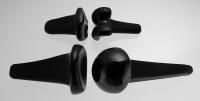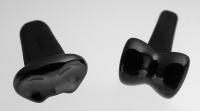| Small joint arthoplasty has been an
ongoing problem of hand surgery. The delicate and anatomically precise
joints of the fingers function within a very narrow tolerance of friction
and mechanical balance of bone and soft tissue forces. Historically, rigid
(metal and plastic) implants have failed because the mechanical mismatch
at the bone-implant interface has resulted in implant displacement due
to reactive bone remodelling. Flexible (silicone rubber) implants have
failed because of implant breakage, erosive reaction to implant wear debris,
and inability of flexible implants to provide rotational and lateral stability.
Pyrolytic carbon implant arthroplasty of the finger joints appears to
be an improvement on previous strategies, as it mimics the normal joint
mechanics, lack of wear debris and a close match to the mechanical characteristics
of the finger bones. |







